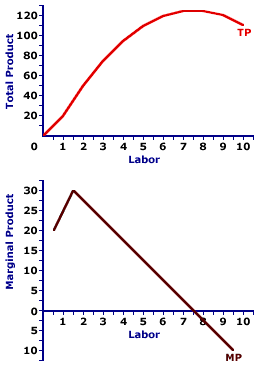
|
|
CHANGE IN QUANTITY SUPPLIED: The movement along a supply curve caused by a change in the price of the good. This should be contrasted directly with a change in supply. You might also want to review the terms change in quantity demanded and change in demand, as well. A change in quantity supplied means that we have identified a NEW quantity on the existing supply curve. In contrast, a change in supply means that we have changed, moved, or shifted, the entire supply curve, the whole range of prices and quantities has changed.
Visit the GLOSS*arama
|
|


|

|
                           TOTAL PRODUCT AND MARGINAL PRODUCT: A mathematical connection between marginal product and total product stating that marginal product IS the slope of the total product curve. If the total product curve has a positive slope (that is, is upward sloping), then marginal product is positive. If the total product curve has a negative slope (downward sloping), then marginal product is negative. If the total product curve has a zero slope (horizontal), then marginal product is zero. The relation between total product and marginal product is one of several that reflect the general relation between a total and the corresponding marginal. There general relation is this: A marginal is the slope of the total curve. Marginal is another term for slope.The general relation between total and marginal surfaces throughout the study of economics, especially utility (total utility and marginal utility), cost (total cost and marginal cost), revenue (total revenue and marginal revenue), and consumption (consumption expenditures and marginal propensity to consume). Making Tacos| Total and Marginal Product |  |
This two-paneled graph for the hourly production of Super Deluxe TexMex Gargantuan Tacos (with sour cream and jalapeno peppers) that visually illustrates the connection between total product and marginal product.- For the first few quantities of the variable input (the number of workers), total product in the top panel is positive AND the slope of the total product curve increases, it becomes steeper. This corresponds with a positive and increasing marginal product in the bottom panel.
- For the next several quantities of the variable input, the slope of the total product curve flattens out, although positive, the slope decreases. This corresponds to a decreasing marginal product in the bottom panel.
- For the last few quantities of the variable input, the slope of the total product curve in the top panel is negative. This corresponds with a negative marginal product in the bottom panel.
The Law of Diminishing Marginal ReturnsThe prime conclusion to drawn from this is the key role played by the law of diminishing marginal returns in the slope of both the marginal product curve and the total product curve. The "hump shape" of the marginal product curve is a direct reflection of first increasing marginal returns, as marginal product rises to a peak, then decreasing marginal returns and the onset of the law of diminishing marginal returns as marginal product falls.However, because the marginal product curve is essentially a plot of the slope of the total product curve, the shape of the total product curve also reflects the law of diminishing marginal returns. The increasingly steep slope of the total product curve for small quantities of the variable input is due to increasing marginal returns. Then with the onset of the law of diminishing marginal returns causes the total product curve to flatten out and subsequently turn down.

Recommended Citation:TOTAL PRODUCT AND MARGINAL PRODUCT, AmosWEB Encyclonomic WEB*pedia, http://www.AmosWEB.com, AmosWEB LLC, 2000-2024. [Accessed: May 2, 2024].
Check Out These Related Terms... | | | |
Or For A Little Background... | | | | | | | | | | |
And For Further Study... | | | | | | | | |
Search Again?
Back to the WEB*pedia
|



|

|
BEIGE MUNDORTLE
[What's This?]
Today, you are likely to spend a great deal of time at a dollar discount store seeking to buy either a birthday gift for your grandfather or a pleather CD case. Be on the lookout for bottles of barbeque sauce that act TOO innocent.
Your Complete Scope
This isn't me! What am I?
|

|
|
The Dow Jones family of stock market price indexes began with a simple average of 11 stock prices in 1884.
|

|
|
"Leadership is based on inspiration, not domination; on cooperation, not intimidation. " -- William A. Ward
|

|
WAPM
Weak Axiom of Profit Maximization
|

|
|
Tell us what you think about AmosWEB. Like what you see? Have suggestions for improvements? Let us know. Click the User Feedback link.
User Feedback
|


|


